by Edward Havens
BENDIGO, AUSTRALIA - The operating tramway museum at Bendigo, Australia, has restored a 102-year-old tram for tourist excursions, The Bendigo Advertiser newspaper reported on its web site December 9th. It runs over the partial route of the previous revenue service tramway. It also has more operating four wheel Birneys than any other museum worldwide.
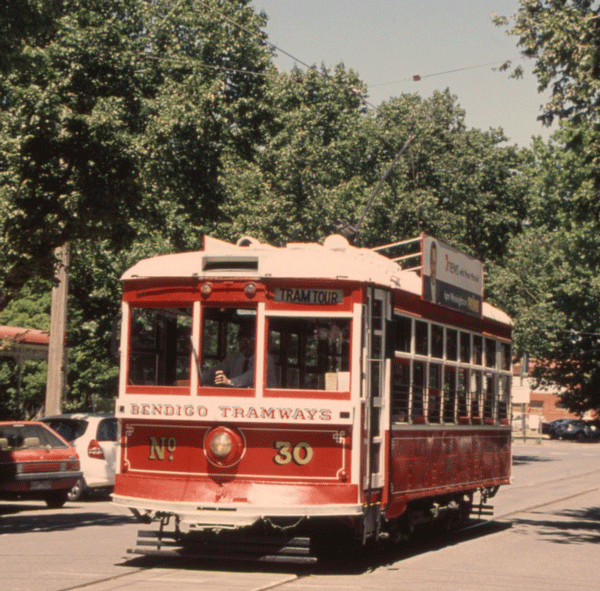
Former Bendigo Birney - Note left hand door!
BETHESDA, MD - The "transportation today" website in a post December 22nd reported that the Maryland Transportation Authority [MTA] light rail line from Bethesda to New Carrollton will not be delayed by a lawsuit filed by its opponents. The 16-mile suburban LRT route will connect with Washington, D.C., Metro rail rapid transit lines. Opponents of light rail at Chevy Chase, an upscale suburb, hoped to scrap the LRT project.
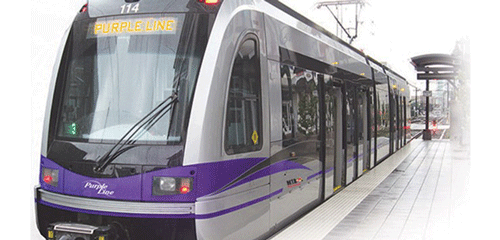
BOSTON, MA - Two Mattapan-Ashmont trolley shuttle PCCs collided on December 29th near the Cedar Grove station, WBZ-TV reported, noting that 17 people were injured. The private right-of-way collision made it difficult for emergency responders to access the site in frigid, snowy conditions. There was no evidence drugs or alcohol were involved.
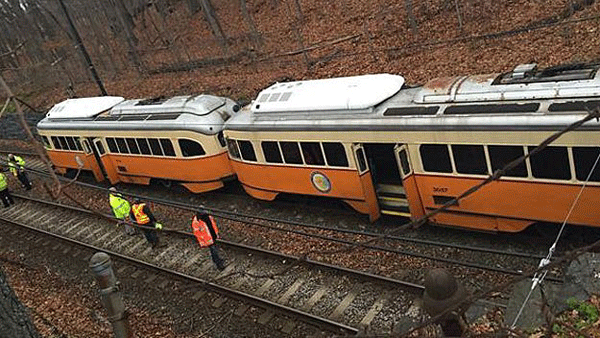
Investigators want to know if a third PCC stopped on the opposite track had anything to do with the rear ender in the Dorchester section of Boston. Rider Antonio Rodriguez told CBS local that the trolley he was on stopped because there was another PCC ahead of them at Ashmont and another PCC came up from behind and slammed into the car he was riding. All injuries appeared to be non-life threatening.
CORK, IRELAND - The city of Cork, Ireland, which is 137 miles southwest of the capital city of Dublin, needs a light rail system similar to Dublin's Luaa to cope with future population growth, according to the "Cork Evening Echo" on December 18th. Cork has a estimated population of more than 125,000 but that is expected to double in the near future. One official suggested starting with bus rapid transit on the route of LRT and laying rails later on.
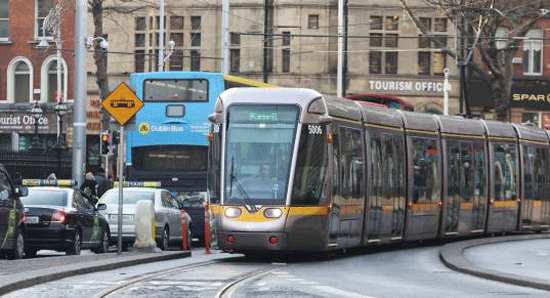
DETROIT, MI - M-1 Rail, the owner of the Detroit QLine modern streetcar line from downtown to midtown on Woodward Avenue has decided to expand th operating hours of its Brookville Equipment "Liberty' model streetcars with the change already effective January 1, 2018, the Detroit Metro Times reported December 29th. QLine will add 11 hours weekly to its schedule with the expanded hours at night to better connect riders with nightlife and special events. Cars will run until midnight Monday through Thursday, until 2 a.m. Friday and Saturday, and until 11 p.m. on Sunday.
JERSEY CITY, NJ - The Jersey City extension of the Hudson Bergen Light Rail westward to Route 440 could be a boon to neighborhM-1 Rail, the owner of the Detroit QLine modern streetcar line from downtown to midtown on Woodward Avenue has decided to expand th operating hours of its Brookville Equipment "Liberty' model streetcars with the change effective January 1, 2018, the Detroit Metro Times reported December 29. QLine will add 11 hours weekly to its schedule with the expanded hours at night to better connect riders with nightlife and special events. Cars will run until midnight Monday through Thursday, until 2 a.m. Friday and Saturday, and until 11 p.m. on Sunday. oods, according to a December 18th Jersey Journal report on the "nj dot com" website. The project for urban revitalization was expected to receive a $5 million jump start from the NJ Transit board in the form of an engineering contract. The extension would provide a one-seat LRV ride between the Hudson and Hackensacek rivers. A 100-acre real estate project is planned for the end of the western extension including 8,000 residential units, retail and commercial shops and parks.
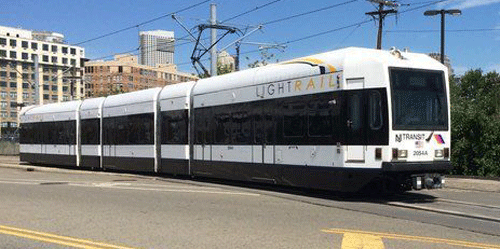
KANSAS CITY, MO - The City Council of Kansas City hopes to put its streetcar expansion plan back on track with a new ordinance to remedy problems created by an August 2017 citywide referendum, the "KC Star" website reported December 22nd. The referendum passed on a narrow vote requires the city to hold a citywide vote on each new streetcar expansion and there are two on the agenda -- south to the University of Missouri-K.C. campus, and north to Riverfront park. Streetcar opponents passed their measure on a 51 to 49 percent vote. The ordinance to correct problems created by the August 8 referendum will be considered by the City Council in January.
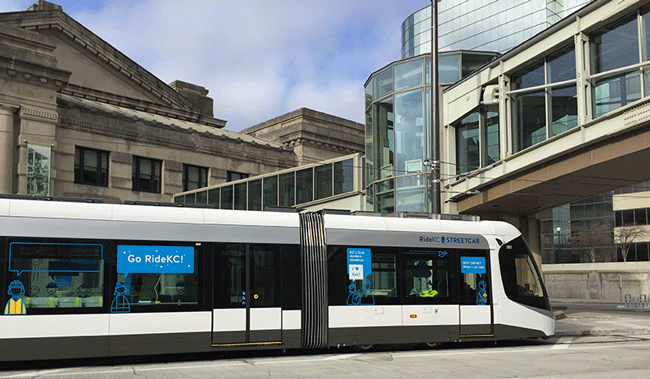
LOS ANGELES, CA - Los Angeles County Transportation Authority [LACMTA or Metro] held a groundbreaking ceremony through its Foothill Construction Authority Saturday, December 2, for the Souza to Montclair extension of the Gold Line light rail route, the Associated Press reports.
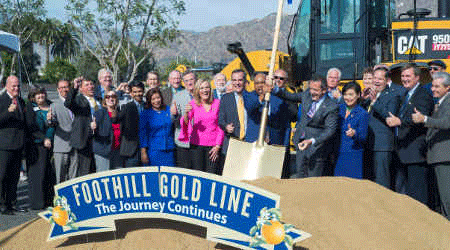
Local Officials, including Los Angeles Mayor Eric Garcetti, at the Ceremony!
The Glendora-Montclair segment is the third and final phase of Metro's Gold Line extension. The first phase connecting downtown Los Angeles to Pasadena, California, was completed in 2003, while the second phase between Pasadena and Azusa opened in March 2016. The 12.3-mile, $1.5 billion project will have six stations. The project would allow riders from Montclair to ride to Santa Monica. It's unclear if zone fares might be adopted.
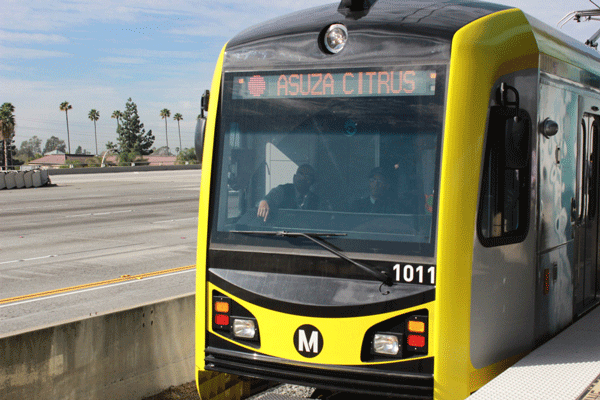
2014-built KinkiSharyo P3010 on the Los Angeles to Azusa "Gold" Line!
MILWAUKEE, WI - Work is beginning on installation of electrical substations for the 2.5-mile downtown modern streetcar in Milwaukee, Wisconsin's largest city, the "on milwaukee dot com" site reported December 12th. The three Traction Power Substations will generate 750v DC and each rectangular structure will be 14 feet wide by 40 feet long and covered in a brick-like siding. The units will be 14 feet high. One of the substations will be next to the car lines Operations and Maintenance Facility (car house).
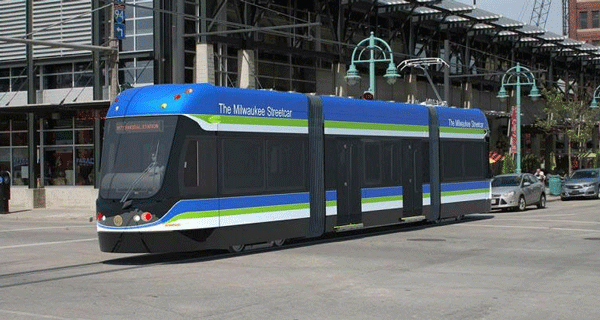
Milwaukee Streetcar Concept!
According to a December 28th report from Progressive Railroading, Milwaukee Mayor Tom Barrett announced just before Christmas that crews have installed 90 percent of the track for the Milwaukee Streetcar's initial route. Workers were able to complete the installation in one construction season thanks in part to "favorable fall weather," Barrett wrote in a year-end report on the project. The remaining portion of the initial route will be completed in 2018. Passenger service is slated to begin by the end of 2018.
The first 2.1-mile phase of the streetcar will run from the Milwaukee Intermodal Station in the city's downtown to the lower east side. In July 2016, the Milwaukee Common Council approved funding for a 0.75-mile streetcar extension to the downtown convention center, the shops of Grand Avenue and the future site of the Milwaukee Bucks Arena. Workers have installed tracks and overhead wire on Ogden Avenue on Milwaukee's east side.
For the streetcar's first year of operation, rides will be free due to a sponsorship agreement with the Forest County Potawatomi Community. As a result of the $10 million, 12-year sponsorship pact, the streetcar will be named "The Hop, presented by Potawatomi Hotel and Casino." In September, the city selected Transdev Services Inc. to serve as the streetcar operations and maintenance contractor. Meanwhile, business leaders have announced plans for new developments to be located along the streetcar route, including a 25-story tower for BMO Harris Bank. Several companies have cited the streetcar among their reasons for the investments, according to Barrett's report.
NEW YORK, CITY, NY - Staten Island Advance on its "Sl Live" web site reported on Sunday, December 3, that there are various ideas to fix transportation woes on New York City's "forgotten" borough. One idea is a westside light rail line to link with NJ Transit's Hudson-Manhattan Light Rail line at Bayonne, N. J., using the bridge across the bay. Another idea is bus rapid transit over five miles from St. George, the ferry terminal to New York, with Arlington, a rail rapid transit line abandoned in 1953.
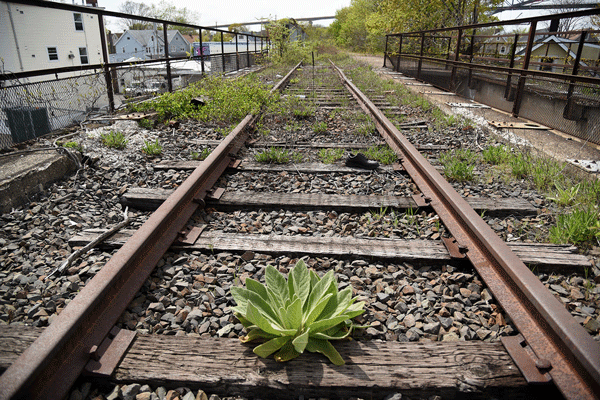
Abandoned North Shore Branch railroad freight line in Staten Island!
OMAHA, NE - Omaha television station KMTV reported December 11th that the public debate over building a modern streetcar line in the Midwestern city has narrowed down to who will ride it. The Nebraska city has hired a consulting firm to evaluate the streetcar proposal. It would be the second streetcar line in Omaha since World War II when the Omaha & Council Bluffs first generation line was converted to all-bus operation.
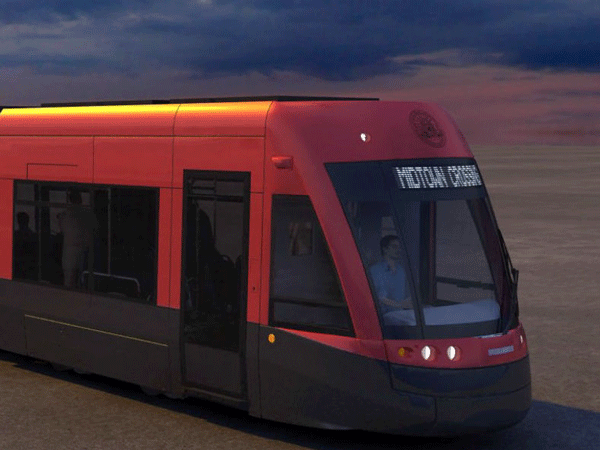
Omaha Streetcar Concept!
PHILADELPHIA, PA - Philadelphia-based Southeastern Pennsylvania Transportation Authority [SEPTA] replaced their double-end Kawasaki LRVs with buses from 69th Street Terminal to Media the first weekend of December, the "delco times" reported. The bus substitution was for rail system maintenance work.
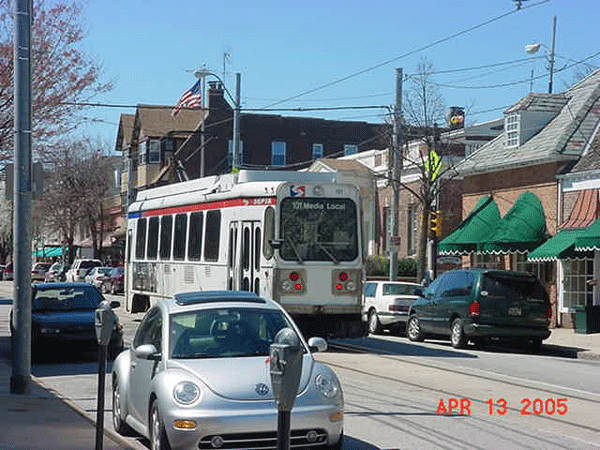
One of SEPTA's 29 1981-built Kawasaki Double-End LRVS in Media!
SANTA ANA, CA - Bids from street railway construction contractors will be due in March 2018 for the proposed Sants Ana to Garden Grove modern streetcar line, the "progressive railroading" site reported December 27th. It would partly use abandoned Pacific Electric [PE] right of way. The contract could be awarded by Orange County Transportation Authority in April. The $299 million project would be funded by state and federal dollars, along with Measure M passed by Orange County voters. That half-cent sales tax was passed by the county voters.
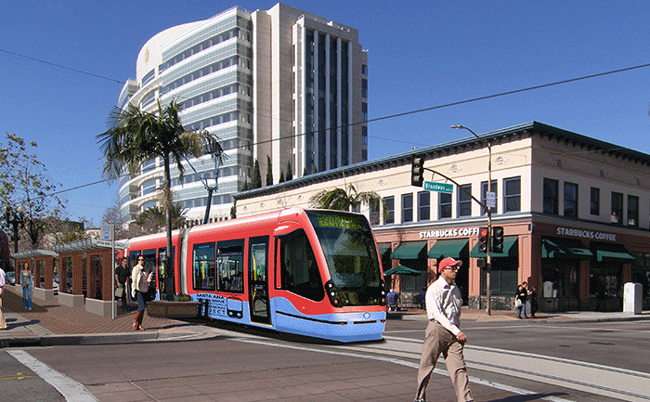
Santa Ana Concept Streetcar at Broadway!
SEATTLE, WA - Seattle-based Sound Transit will seek $1.17 billion in federal funding for construction of the Lynnwood light rai extension north from Northgate Mall, the "mountlake terrace" website reported December 23rd. The overall cost of the project, including financing costs, is $3.07 billion.,The light rail line will break ground in 2018 and start providing revenue service in 2024. The proposed 8.5-mile route will parallel Interstate 5 and the application must be reviewed by Federal Transit Administation and the Trump White House.
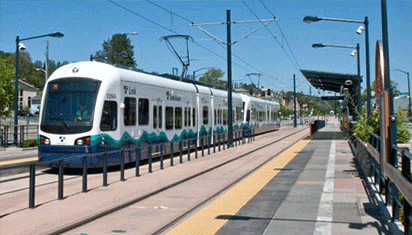
Two of Sound Transit's 62 KinkiSharyo low floor light rail vehicles.
TORONTO, ONTARIO, CANADA - CBC News reported on December 23rd that buses will replace streetcars on some routes because of the failure of Bombardier Transportation to meet its commitment to deliver promised Flexity articulated streetcars for the legacy broad gauge system in the Toronto urban core. Toronto Transit Commission plans to move streetcars from 505-Dundas and 506-Carlton to more crowded rail routes. Bombardier only will have 63 Flexity cars on TTC by the end of year 2017 compared to an initial projection of 145.
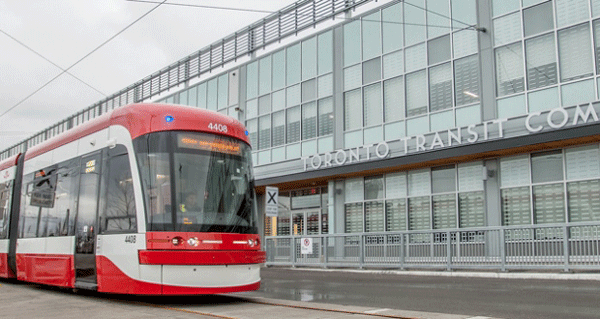
TTC Flexity 4408 in front of the Leslie facility.
WILLIAMSPORT, PA - The Williamsport, Pa., Sun-Gazette in an historical article December 11 recalls that the north-central Pennsylvania city had a streetcar system until the early 1930s, The most modern cars were built by Brill of Philadelphia and wound up being sold to Lehigh Valley Transit at Allentown, Pa. where they operated until the end of local rail service in 1953.
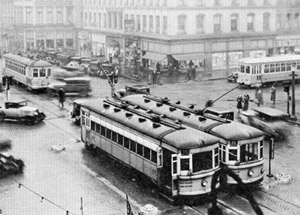 Williamsport's Market street in 1933 just before the end of streetcar service! Williamsport's Market street in 1933 just before the end of streetcar service!
|
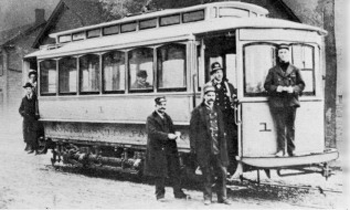 Montoursville Passenger Railway Company Car #1 on East Third Street in Williamsport around 1900! Montoursville Passenger Railway Company Car #1 on East Third Street in Williamsport around 1900! |